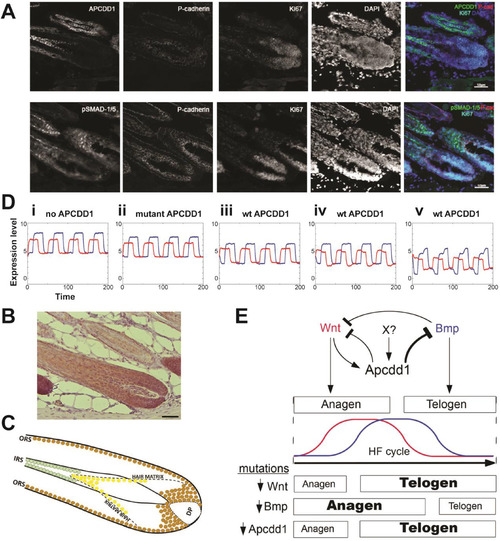Fig. 7
- ID
- ZDB-FIG-200723-23
- Publication
- Vonica et al., 2020 - Apcdd1 is a dual BMP/Wnt inhibitor in the developing nervous system and skin
- Other Figures
- All Figure Page
- Back to All Figure Page
|
APCDD1 protein is expressed in mouse hair follicles and can coordinate hair follicile dynamicsA. Immunofluorescence staining of adult mouse hair follicle cryosections detects expression of APCDD1 (upper row) and respectively pSmad1/5 (lower row) in relation to hair follicle matrix marker P-cadherin and proliferation marker Ki67. The two sections are 20 μm apart. Nuclei are visualized with DAPI. Stains were performed on 6 mice, having 7-8 sections per mouse. B. In mouse hair follicles paraffin sections, activated β-catenin (brown) is present in the hair matrix abutting the dermal papilla (DP) and in the outer root sheet (ORS). Scale bar: 50 μm. Stains were performed on 6 mice, having 7-8 sections per mouse. C. Schematic of immunodetection results. Activated β-catenin (brown), an effector of Wnt signaling, is localized along the outer root sheath (ORS) and hair bulb, surrounding the dermal papilla (DP) that produces the growth signals during anagen. Nuclear pSMAD-1/5 (yellow), an effector of BMP signaling, is located in the distal portion of the hair matrix, where keratinocytes begin to differentiate into the layers of the inner root sheath (IRS). APCDD1 expression (green) is localized to the mature keratinocytes of the IRS, consistent with its function to downregulate both Wnt and BMP signaling. D. Mathematical model of the hair follicle temporal activation dynamics of the BMP and Wnt pathways (pSmad1 in blue, β-catenin in red). The BMP and Wnt ligand inputs are periodic, have the same period and are out of phase by a quarter of a period. Cases shown: (i) no APCDD1 is present, as in null mutants; (ii) mutant APCDD1, which is a very weak inhibitor (Shimomura et al., 2010); (iii) wild type APCDD1, which inhibits Wnt signaling (Shimomura et al., 2010) and BMP signaling; (iv) wild type APCDD1, and added moderate repression of Wnt signaling by BMP signaling; (v) wild type APCDD1, added moderate repression of Wnt signaling by Bmp signaling, and Apcdd1 is induced by Wnt signaling. The absence of Apcdd1 allows higher levels of pSmad1; wild type Apcdd1 depresses pSmad1 levels. E. APCDD1 may control the duration of the phases of the hair follicle cycle. Summary of Apcdd1 activity: First, APCDD1 expression is induced by Wnt signaling and also by a currently unidentified factor X, which maintains APCDD1 after Wnt signaling ceases. Second, APCDD1 represses both BMP signaling and Wnt signaling (which also is repressed by BMP signaling). Bmp and Wnt signaling together control the duration of hair follicle phases anagen (when hair grows) and telogen (when hair falls out). Third, mutations inactivating Wnt signaling, or Bmp signaling, or APCDD1, result in changed durations of anagen and telogen. |
Reprinted from Developmental Biology, 464(1), Vonica, A., Bhat, N., Phan, K., Guo, J., Iancu, L., Weber, J.A., Karger, A., Cain, J.W., Wang, E.C.E., DeStefano, G.M., O'Donnell-Luria, A.H., Christiano, A.M., Riley, B., Butler, S.J., Luria, V., Apcdd1 is a dual BMP/Wnt inhibitor in the developing nervous system and skin, 71-87, Copyright (2020) with permission from Elsevier. Full text @ Dev. Biol.

